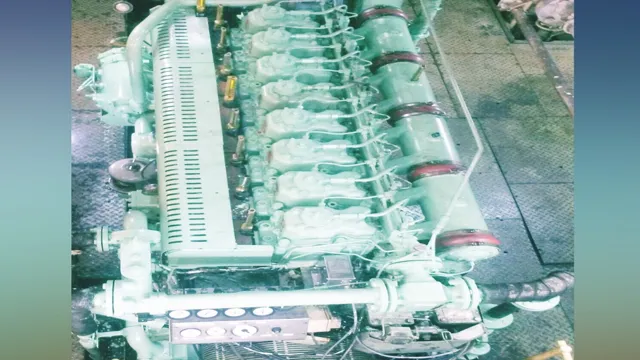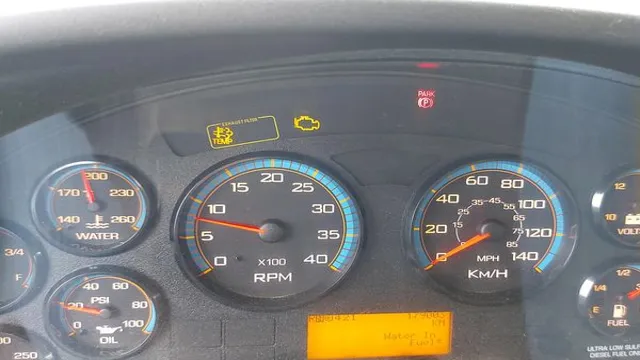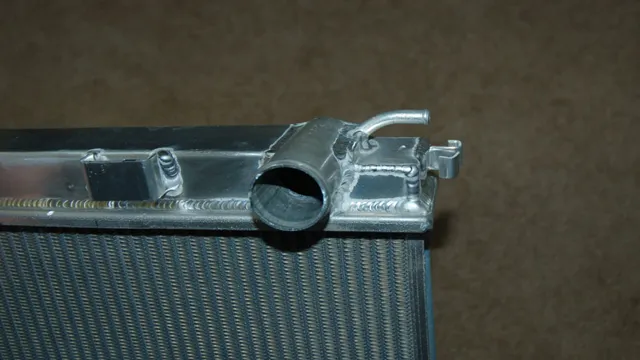Rev up your engine knowledge: Expert tips on fixing high exhaust temperatures in your International Truck
Have you noticed that your International truck’s engine has been running at a high exhaust temperature lately? If so, you’re not alone. Many truck drivers have experienced this issue, which can be caused by a variety of factors. However, it’s important to address high exhaust temperatures as soon as possible to avoid potential engine damage and costly repairs.
In this blog post, we’ll explore the possible causes of high exhaust temperatures in International trucks and provide you with some tips on how to fix the issue. From faulty sensors to dirty air filters, we’ll cover all the possible culprits and offer some practical solutions to help you get your truck back on the road as soon as possible. Whether you own a fleet of International trucks or you’re a lone driver, addressing high exhaust temperatures is crucial for the longevity and efficiency of your vehicle.
So, let’s dive into the causes of this common issue and discover how you can fix it.
Check for Overheating Causes
If you’re experiencing high exhaust temperature in your International truck, the first thing you should check is the causes of overheating. Overheating can cause a chain reaction of problems that can lead to more serious engine damage if not addressed promptly. There are several reasons why your truck may be overheating, such as a clogged radiator, faulty thermostat, damaged water pump, or a leaking coolant system.
Additionally, a broken fan belt or a malfunctioning fan clutch can also cause your truck to overheat. When troubleshooting, it is essential to inspect the entire cooling system to ensure all components are working correctly. Regular maintenance is crucial to prevent overheating issues and to keep your truck running smoothly.
Remember, failing to address overheating can lead to costly repairs and potentially dangerous driving conditions.
Inspect the Engine Cooling System
Inspecting the engine cooling system is an essential step in car maintenance to avoid overheating problems. Overheating can be caused by different factors, such as a faulty thermostat, a damaged radiator, or a blown head gasket. It is essential to check the cooling system for leaks, corrosion, and debris buildup regularly.
The coolant level should also be inspected periodically and replaced if necessary. If the engine temperature gauge indicates that the engine is running hot, it’s crucial to stop driving immediately and let the engine cool down before continuing to drive. Neglecting the cooling system can lead to costly repairs and jeopardize the safety of the driver and passengers.
Therefore, it’s wise to schedule regular check-ups with a trusted mechanic to ensure that your cooling system is functioning correctly and efficiently.

Examine the Exhaust System
When it comes to automotive maintenance, it’s crucial to examine the exhaust system regularly. Overheating causes can greatly affect the exhaust system’s functionality and lead to more severe problems. One of the main causes of overheating is a malfunctioning catalytic converter, which can cause blockages in the exhaust system and lead to backpressure.
This backpressure causes the engine to work harder and produce more heat, ultimately causing the vehicle to overheat. Another common cause of overheating is a leak in the exhaust system, which can cause the engine to take in excessive air and lead to an increased temperature. Regularly checking your exhaust system for leaks, blockages, and wear and tear can help to prevent overheating and ensure your vehicle runs smoothly.
So the next time you’re doing maintenance on your car, be sure to examine your exhaust system thoroughly to ensure it’s working correctly.
Check for Fuel Issues
One common cause of high exhaust temperature in an International truck is fuel issues, which can lead to incomplete combustion and a buildup of heat in the engine. To fix this problem, it’s important to check for any clogs in the fuel filter or lines that can restrict fuel flow. Additionally, make sure the fuel injectors are functioning properly and delivering the correct amount of fuel to the engine.
If these components are not working as they should, it can cause the engine to run lean and generate excess heat. It’s also a good idea to check the fuel quality and ensure that it meets the manufacturer’s specifications, as lower quality fuel can cause combustion problems. By addressing any fuel issues and ensuring proper fuel delivery and quality, you can help regulate the engine temperature and prevent unnecessary wear and tear on your International truck.
Investigate the Fuel Injectors
If your vehicle is suffering from fuel-related issues, one of the first things you should investigate is the fuel injectors. Fuel injectors play a crucial role in delivering fuel to the engine, and if they’re not functioning properly, your vehicle may not run smoothly or efficiently. Some common symptoms of fuel injector problems include rough idling, reduced engine power, and poor gas mileage.
To check for fuel injector issues, a mechanic can perform a fuel system scan and test the fuel injectors for proper operation. It’s important to address fuel injector problems promptly to prevent further damage to your engine and ensure your vehicle runs at its best. By keeping an eye out for fuel-related issues and having your fuel injectors checked regularly, you can keep your vehicle running smoothly and avoid costly repairs down the road.
So, if you’re noticing any symptoms of fuel injector issues, don’t hesitate to take your vehicle in for a check-up.
Check the Air/Fuel Ratio
When checking for fuel issues, one important aspect to consider is the air/fuel ratio. This ratio refers to the amount of air and fuel that is mixed together before combustion in the engine. Ideally, the perfect ratio is 1
7 parts of air to 1 part of fuel. However, if there is too much or too little fuel being used in this mixture, it can lead to problems with fuel efficiency and engine performance. There are a few different ways to check the air/fuel ratio, including using an oxygen sensor or a wideband gauge.
By monitoring this important aspect of your engine’s performance, you can identify any issues early on and take steps to address them before they cause bigger problems down the line. Don’t forget to regularly check your vehicle’s air/fuel ratio as part of your ongoing maintenance routine.
Examine the EGR Valve
When it comes to examining the EGR valve, one of the fuel issues to look out for is clogging. Over time, carbon and other debris can accumulate inside the valve leading to decreased airflow and fuel efficiency. To check for clogging, the valve can be removed and inspected for any build-up.
If clogging is detected, a simple cleaning should do the trick. Another fuel issue that can affect the EGR valve is a malfunctioning fuel injector. This can lead to incorrect fuel delivery and cause the entire system to malfunction.
By keeping up with regular maintenance checks and catching issues early on, you can avoid costly repairs and ensure your engine is running smoothly.
Perform a Regeneration Cycle
Are you experiencing high exhaust temperature in your International Truck? One of the ways to fix this problem is by performing a regeneration cycle. This process helps to burn off the accumulated soot in the diesel particulate filter (DPF). The DPF works by capturing harmful particulates and releasing them in a controlled and safe manner.
However, over time, soot accumulates and reduces the effectiveness of the DPF. This can lead to increased exhaust temperature and reduced engine performance. To perform a regeneration cycle, ensure that your truck is in a safe and well-ventilated area, then follow the manufacturer’s instructions for initiating the cycle.
This process will heat up the DPF and burn off the accumulated soot, restoring the effectiveness of the filter. Regularly performing a regeneration cycle can help to prevent high exhaust temperature and maintain engine performance.
Understand the Diesel Particular Filter (DPF)
If you own a diesel vehicle with a diesel particular filter (DPF), it’s important to understand the process of regeneration. Essentially, regeneration is the process by which the DPF is cleared of buildup to ensure it functions properly. This process occurs automatically during normal driving conditions, but sometimes it’s necessary to perform a manual regeneration cycle.
This is usually indicated by a warning light on your dashboard–if you see this light, it’s important to take action to initiate the regeneration process. Failure to do so can lead to damage to your vehicle and increase the likelihood of costly repairs. So, if you don’t want to spend more money in the long run, make sure to understand the DPF and perform any necessary regeneration cycles.
When to Perform Regeneration Cycle
Performing a regeneration cycle is vital for maintaining the quality and efficiency of your water treatment system. But when should you perform this cycle? The answer depends on the type of system you have and the frequency of use. Generally, if your system is equipped with a meter, it will let you know when it’s time for regeneration.
If not, you should aim for anywhere between every few days to once a week. Keep an eye out for any changes in your water quality, such as a decrease in pressure or an increase in water hardness. These could be signs that it’s time to perform a regeneration cycle.
Regularly performing this cycle will ensure that your system is running at peak performance and reducing the risk of any malfunctions in the future. Remember, taking good care of your system will lead to better water quality and a longer lifespan for your equipment.
Maintenance Tips for Preventing High Exhaust Temp
If you are experiencing high exhaust temperature in your International truck, it is important to address the issue promptly to avoid potential damage to your engine and other components. Regular maintenance is the key to preventing this problem from occurring. Start by checking your air intake and ensuring that it is free from any debris or blockages.
This will help to ensure that your engine is getting sufficient air flow. The next step is to inspect your exhaust system for any leaks. Leaks can cause hot gases to escape and increase the temperature of your exhaust.
Check your exhaust manifolds, gaskets, and pipes for signs of leaks. Another step you can take to prevent high exhaust temperature is to make sure that your engine is running at optimal performance. This can be achieved through regular tune-ups, oil changes, and fuel filter replacements.
Finally, consider upgrading your exhaust system to a more efficient one to help improve performance and lower exhaust temperature. Overall, it is important to stay on top of your truck’s maintenance to prevent high exhaust temperature and ensure optimal performance.
Conclusion
In summary, fixing a high exhaust temperature in an international truck requires a multi-pronged approach. Firstly, check for any clogs or blockages in the exhaust system, as these can cause hot gases to build up. Secondly, make sure that the engine is running at optimal efficiency, which may involve adjusting the air-fuel mixture or replacing any damaged components.
Finally, consider upgrading to a more efficient exhaust system, such as a ceramic-coated header or a high-flow catalytic converter. By taking these steps, you can bring your international truck’s exhaust temperature back to a healthy level and ensure that your engine is running smoothly for miles to come.”
FAQs
What is considered a high exhaust temperature for an international truck?
A high exhaust temperature for an international truck is typically anything above 1,000 degrees Fahrenheit.
What can cause high exhaust temperature in an international truck?
High exhaust temperature in an international truck can be caused by a variety of factors such as a clogged air filter, a faulty turbocharger, or a malfunctioning EGR valve.
What are the consequences of driving an international truck with high exhaust temperature?
Driving an international truck with high exhaust temperature can lead to engine damage, reduced fuel efficiency, and increased risk of fire.
How can I fix high exhaust temperature in my international truck?
To fix high exhaust temperature in an international truck, you will need to diagnose the underlying issue first. This may involve cleaning or replacing the air filter, repairing or replacing the turbocharger, or fixing the EGR valve. It is best to have a qualified mechanic perform these repairs.







